I. Introduction
On Saturday 19th October 2013 our Institute opened its doors for wide public. Our main goal was to present our activities supported by the EAgLE REGPOT Project. We have hosted about 250 visitors very interested in our research work and our laboratory equipment. They represented all ages, from infants to seniors. We have even noticed professors of neighboring universities and retired employees of the Institute. Most of visitors were residents of Warsaw but there were also two buses of youth from Wyszków (small city 60 km from Warsaw). There were also a group of students from one Technical University in a big city outside Warsaw.
The visitors were organized into small groups and guided to eleven laboratories of our Institute. At each of them an interesting physical experiment was conducted. Our guests got know our research subjects and equipment, and also had an unique opportunity to see a number of unusual and intriguing physical effects. Additionally, they were informed on increasing our research abilities due to supporting by the EAgLE Project.
A special proposal have been prepared for parents who came with their children. Kids ages 6 to 9 would attend scientific workshop: “From the symmetry to the crystal growth”. The activity was conducted by Dr. Beata Brodowska and Dr. Izabela Kuryliszyn-Kudelska. The workshop was 50 minutes long and four appointments were conducted at 11:00 a.m., 12:00 a.m., 1:00 p.m. and 2:00 p.m., each for 20 children. Almost 80 “young researchers” attended our workshop.
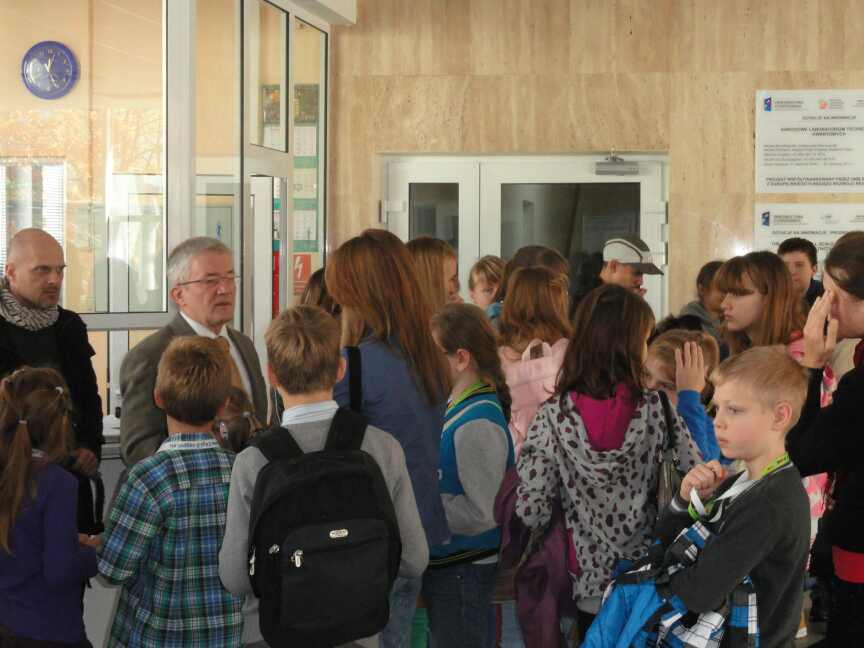
Crowd of young visitors at entrance to the Institute.
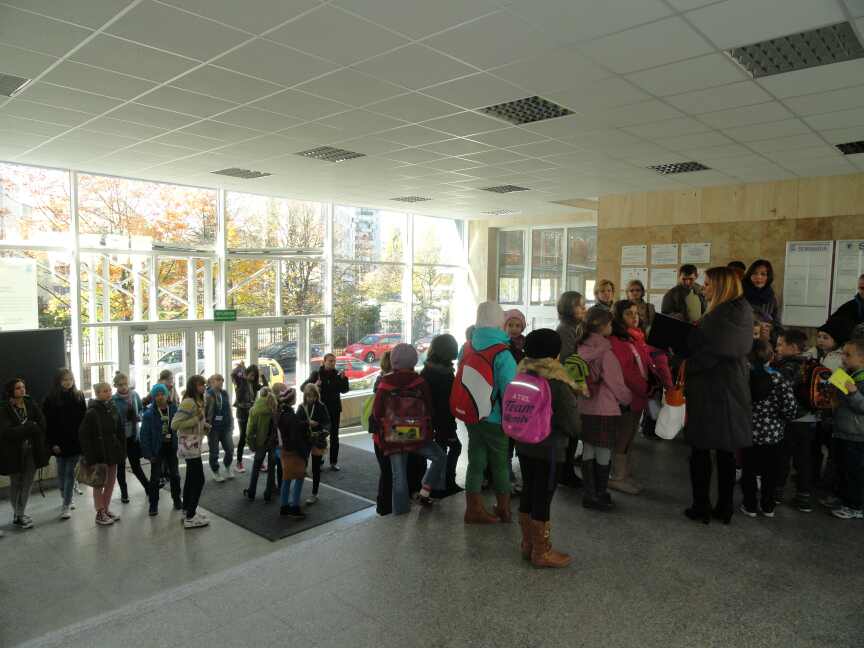
Youth from Wyszków arriving to the Institute.
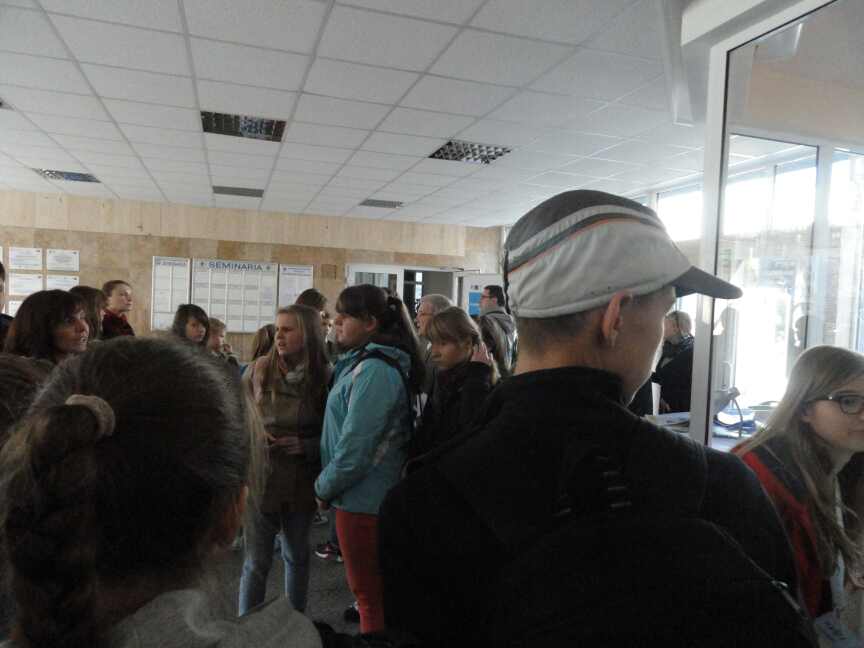
Visitors are waiting for guides who lead them to our laboratories.
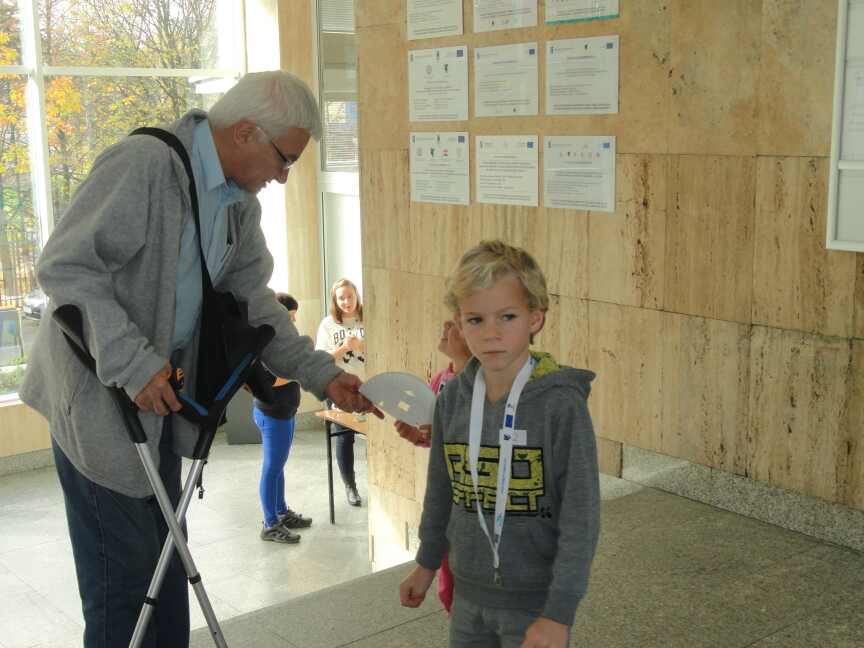
Grandfather with his grandchildren came to visit our Institute.
II. Laboratory activities during the Open Day
The list of the laboratories, the names of researchers,and illustrations and/or descriptions of their activities are given below:
- 1. Laboratory of Biological Physics (SL-4) – Dr. Remigiusz Worch: "Watching microscopic basketball – measuring diffusion of biological molecules"
At the molecular level, mobility of biological molecules is a key phenomenon of all life processes. One of the methods allowing for the molecule diffusion measurements is realized by a fluorescence microscopic technique, which can be introduced in analogy to moving 'players', running through a middle circle on a basketball field. When such player or a molecule induces a signal (fluorescence), after its analysis, the information on diffusion is obtained.
- 2. Laser spectroscopy group (ON-2.2) – Dr. Jacek Szczepkowski: „Laser Spectroscopy”
The visitors learned how the He-Ne and ring dye lasers works, observed Doppler-free saturation spectroscopy of the D-lines in rubidium and luminescence caused by the laser light.
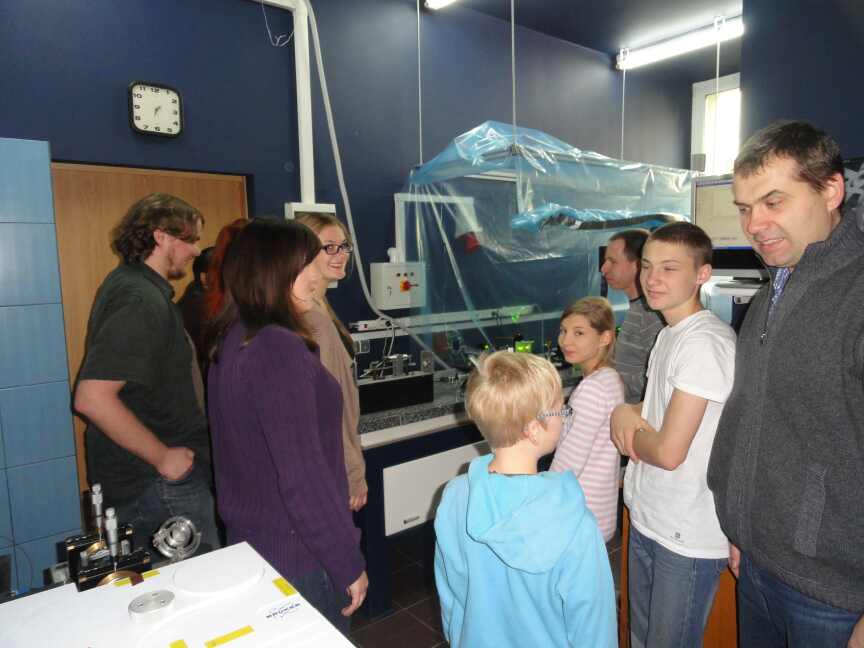
Luminescence caused by the laser light was demonstrated by Dr. Jacek Szczepkowski.
- 3. Group of Oxide Crystals Growth (ON-3) – Prof. Dr. hab. Marek Berkowski, Dr. Michał Głowacki, Dr. Jan Fink-Finowicki: „Demonstration of the crystal growth using Czochralski method”
During demonstration the visitors watched every step of the Czochralski single crystal growth process: preparation of the starting materials, crystal growth and procedures for obtaining oriented and polished crystal samples. After the presentation, they were learned about measurement techniques of single crystals and about the inventor of the method - Prof. Jan Czochralski. Our guests also visited the laboratory of floating-zone crystal growth.
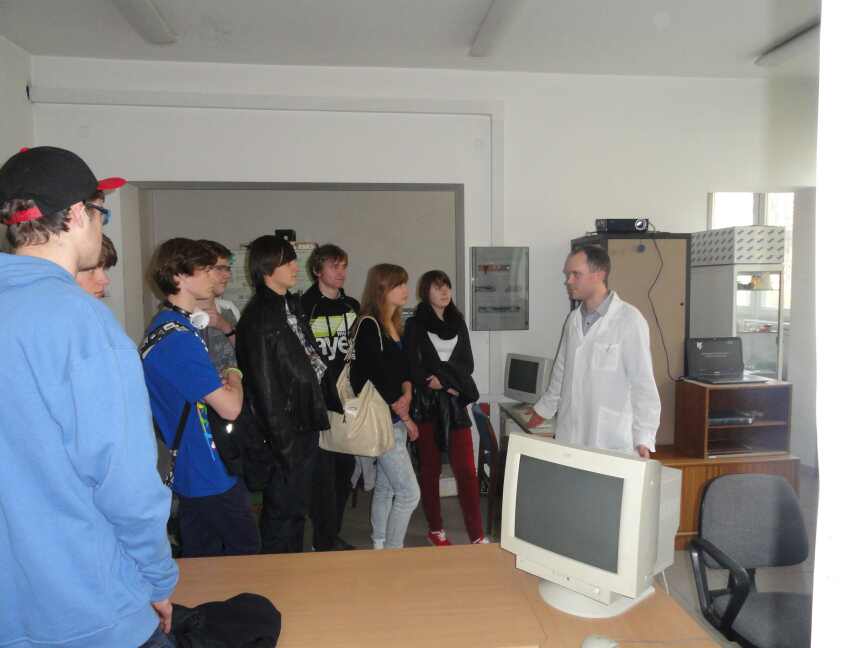
Dr. Michał Głowacki explains the details of the crystal growth
by Czochralski method.
- 4. Low-temperature laboratory (SL-2) – Dr. Paweł Kaczor: „Properties of various bodies at very low temperatures”
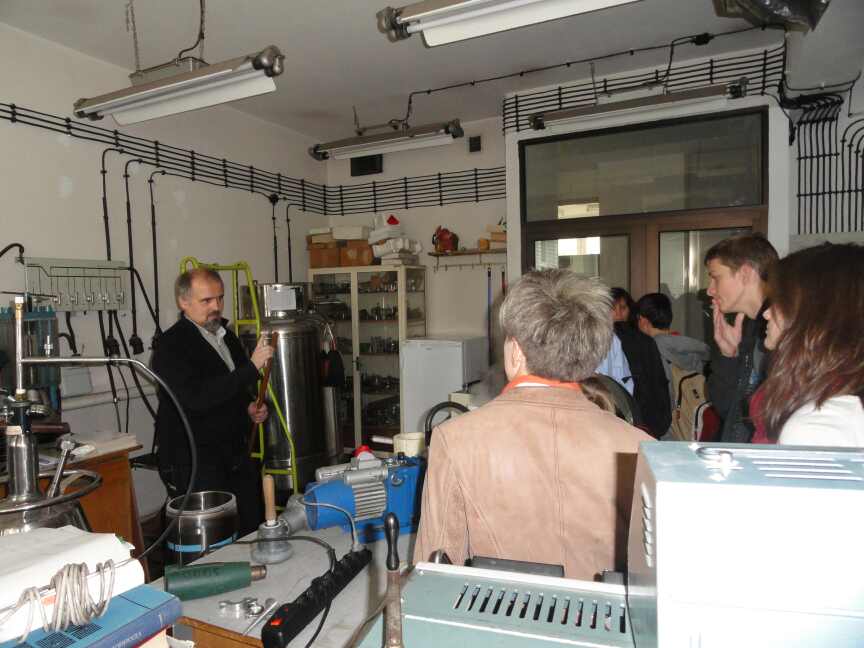
In Laboratory of Spintronic and Cryogenic Reaserch, Dr. Paweł Kaczor guided our guests into the world of very low temperatures. At the beginning, he demonstrated unusual properties of different bodies immersed in liquid nitrogen. One spectacular experiment was observation of increasing the boiling temperature of the liquid nitrogen under increased pressure. Subsequently, the visitors were guided to the laboratory room to look at the dilution refrigerator – an instrument capable to obtain temperatures as low as 20 millikelvins. Finally, Dr. Kaczor explained to visitors principles of liquefaction of gases and main applications of cryogenics in industry and medicine.
- 5. Laboratory of scanning electron microscopy (SL-3.1) – Dr. Tomasz Wojciechowski: „How to make and see objects of nanometer size?”
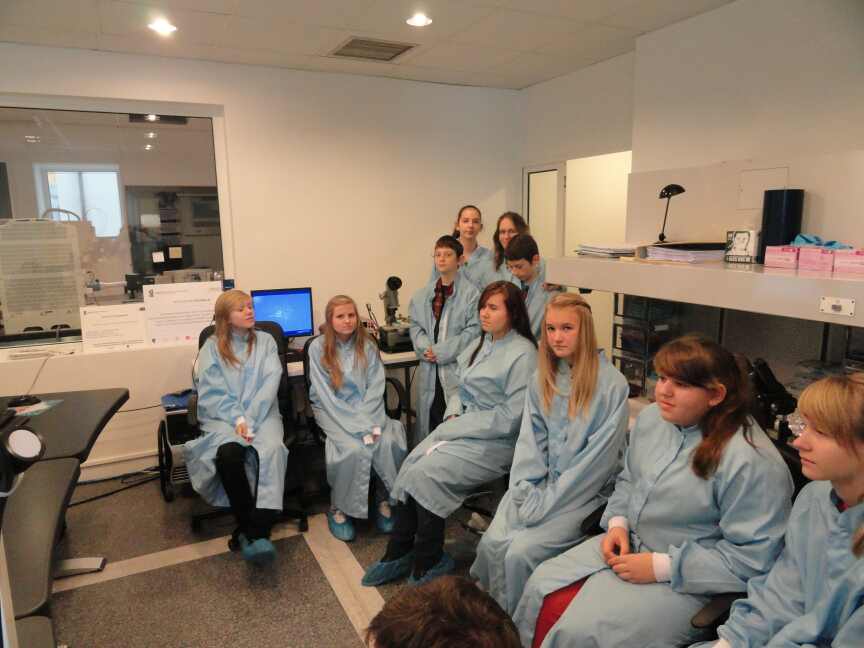
Laboratory of electron beam lithography. Visitors listen to Dr. Tomasz Wojciechowski who explains the method of making objects as small as several nanometers.
- 6. Laboratory of atomic force microscopy – Dr. Marta Aleszkiewicz: „Three-dimensional imaging of semiconductor nanostructures”
In the Atomic Force Microscope (AFM) Lab the three-dimensional surface profiles are investigated. The unique ability of detecting three-dimensional images (instead of two-dimensional projection, typical for "conventional" microscopes) is a feature characteristic for the whole family of instruments known as scanning probe microscopes - some of them are also available in the Lab. Nowadays, the probe microscopy (which started in early 80's with invention of Scanning Tunneling Microscope, STM) is the principal enabling technology for the nanoengineering. Several applications of the probe microscopy are used in the Lab: surface imaging with nanometric resolution, depth profiling for calibration purposes (AFM), local conductance measurement (STM) and surface domain structure (Magnetic Force Microscopy, MFM).
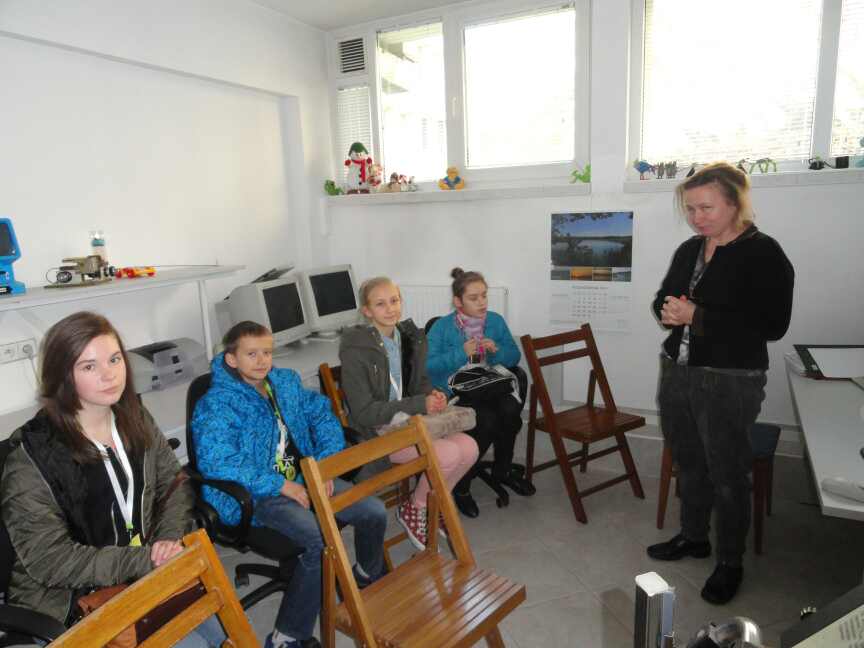
Dr. Marta Aleszkiewicz explains our visitors principles
of operation of the atomic force microscope.
- 7. Laboratory of Molecular Beam Epitaxy – MSc Wojciech Zaleszczyk: "Fabrication of semiconductor structures by stacking single atomic layers"
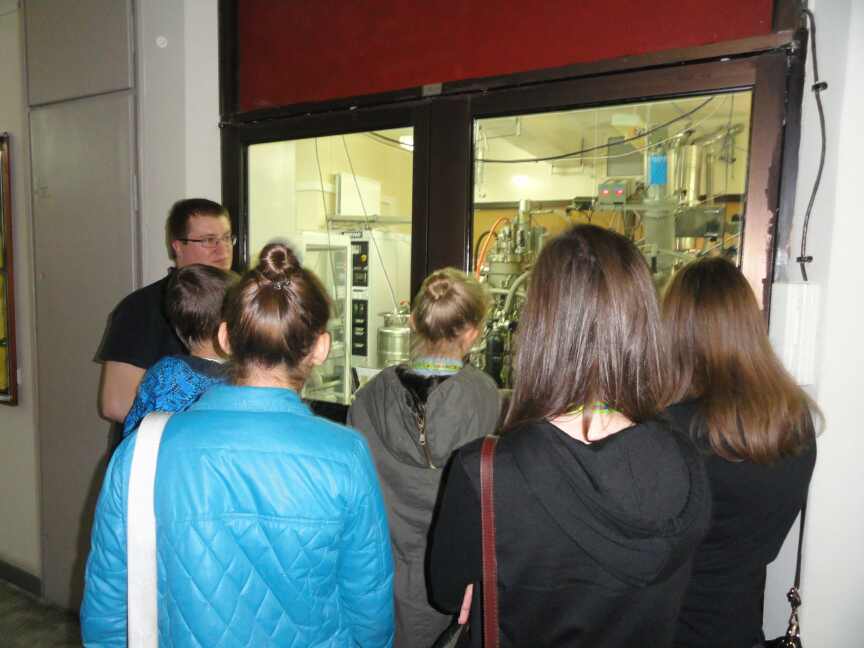
Sightseeing of the laboratory of the growth of the low-dimensional crystals of II-VI semiconductor compounds. The visitors look at the system of two Molecular Beam Epitaxy (MBE) chambers connected to each other through ultra high vacuum transfer chamber. MBE is a method of the atomic layer epitaxial growth of a monocrystalline films on a monocrystalline substrates in ultra high vacuum (vacuum pressure is typically only a few 10−10 Torr). MBE is widely used in the manufacture of semiconductor devices, including laser diodes, transistors for cellular phones and WiFi.
- 8. Laboratory of X-ray structural analysis - Prof. Dr. hab. Wojciech Paszkowicz, Dr. Elżbieta Dynowska, Dr. Roman Minikayev: "What one can see in the Bragg mirror – ordering of atoms in a crystallographic structure"
The aim of the presentation of the X-ray diffraction laboratory was to present the ways of determining the structural properties of crystals and crystalline thin films. During the visits, the general information on the crystalline nature of matter was discussed and a simple measurement showing the Bragg reflections from a silicon crystal was demonstrated. The importance of the diffraction methods for development of optoelectronics and other fields was emphasized. Many groups have visited the laboratory for this presentation. The way of presentation was adopted in each case, depending on the age and education level of the audience.
- 9. Laboratory of Secondary Ion Mass Spectroscopy – Dr. Rafał Jakieła: "Looking for needle in a haystack – how to find trace amounts of substances in solids”
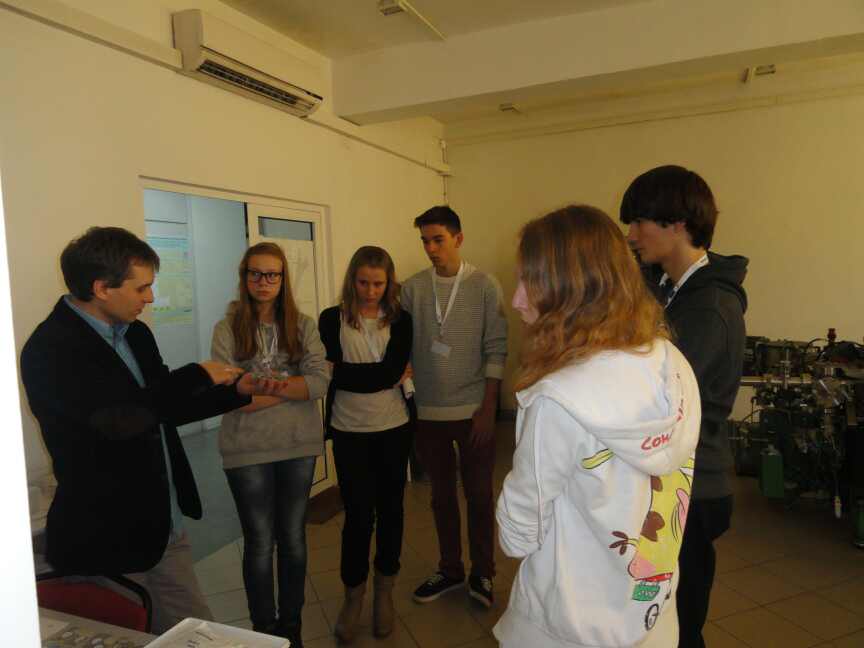
Dr. Rafał Jakieła explains the principles of mass spectroscopy.
- 10. Laboratory of semiconductor spectroscopy – Dr. Vitalii Ivanov: „Luminescence – ‘cold’ light emitted by crystals”
People visiting this laboratory have an opportunity to observe light emission of natural minerals (Diamond, Ruby, Fluorine, Emerald, Sapphire) and synthetic crystals (garnets, sphalerite , corundum etc.). Luminescence of artificially prepared nanostructures excited by laser has been shown. Dr. Ivanov explained mechanisms of different kind of emission (photoluminescence, Raman scattering, nonlinear optical conversion) on the base of quasi classical simple considerations. He has also reviewed the methods and equipments used for optical spectroscopy. Finally, he demonstrated applications of Raman and photoluminescence spectroscopies in:
- tell the difference between diamond and zirconium dioxide
- drugs (organic dyes) detection in food.
- 11. Laboratorium wysokorozdzielczej mikroskopii elektronowej – Prof. nzw. Dr. hab. Piotr Dłużewski, Jerzy Dąbrowski: "We are looking atoms in crystals"
III. EAgLE Workshop for kids
Hands-on activities were conducted for learning the basic concepts in math symmetry and crystal symmetry. Children learned to recognize different types of symmetry by folding and cutting various paper geometrical figures and designs. Children could explore that symmetry is a feature of plants, animals and various objects. In the second part of workshop young researchers learned about crystals. The activities showed the importance of symmetry in crystals. There was a lot of fun in building various models of crystal structures using magnetic sets (balls and rods). Children studied also how to grow crystals. They could also see and touch various semiconducting crystals grown in our Institute. Every participant prepared a table salt crystal growth solution. After workshop young researchers could continue their experiment at home and observe the formation of salt crystals.
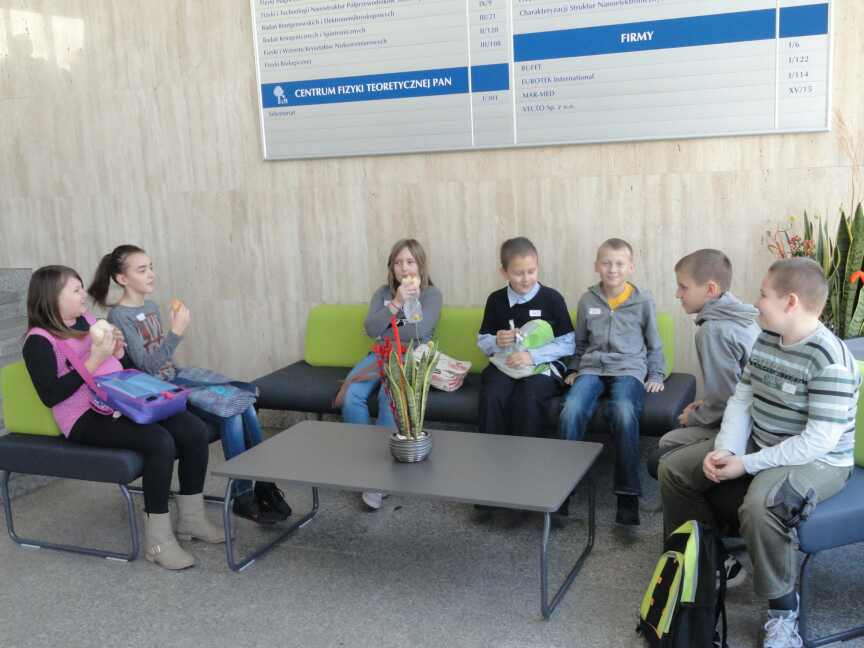
Youngest “researchers” are waiting for their workshop.
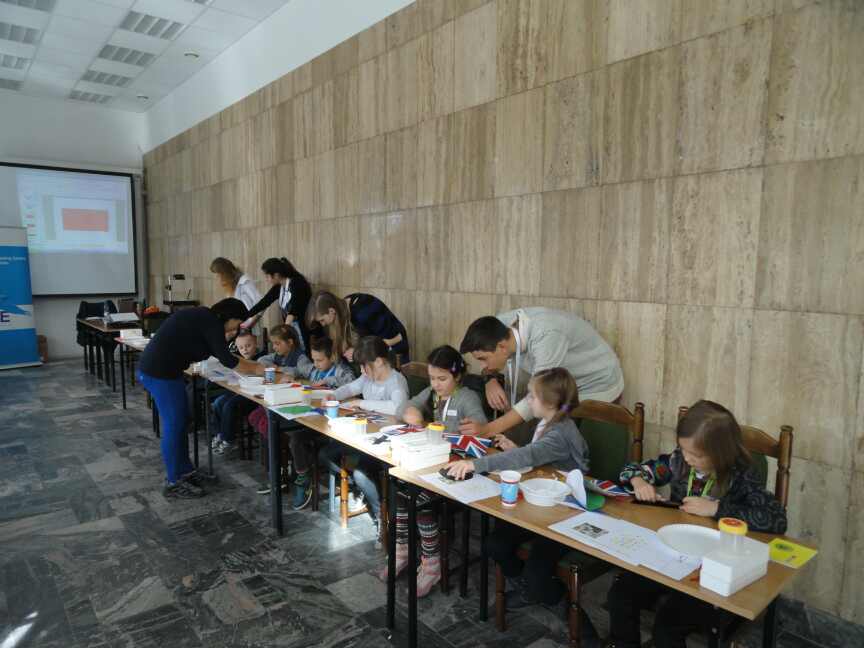
Kids perform physical experiments under supervision of Dr. Beata Brodowska.
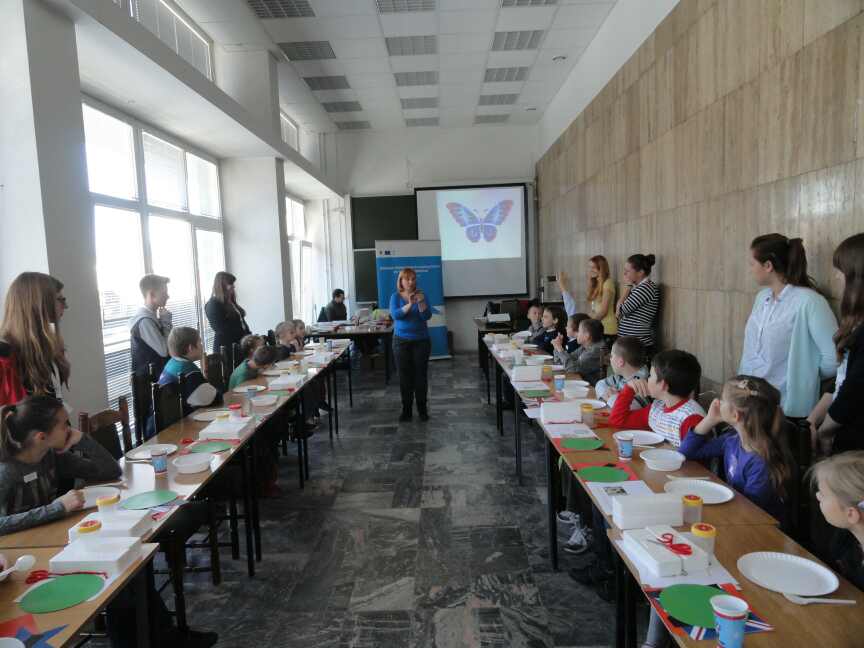
Dr. Iza Kuryliszyn-Kudelska explains for kids the role of symmetry in nature.
Standing are young people from Youth Science Club of Tomasz Zan High School
in Pruszków who helped to run the workshop.
The EAgLE Open Day was held between 11 a.m. and 3 p.m. During this period each laboratory was visited by 6 - 7 groups (up to 10 persons). Several laboratories were especially occupied, so we had to arrange a special enrollment list. The visitors asked many questions which showed their relatively high knowledge in physics. Since many people asked about a subsequent EAgLE Open Day Event, we guess that it should be organized next year, and the program should be significantly extended.













